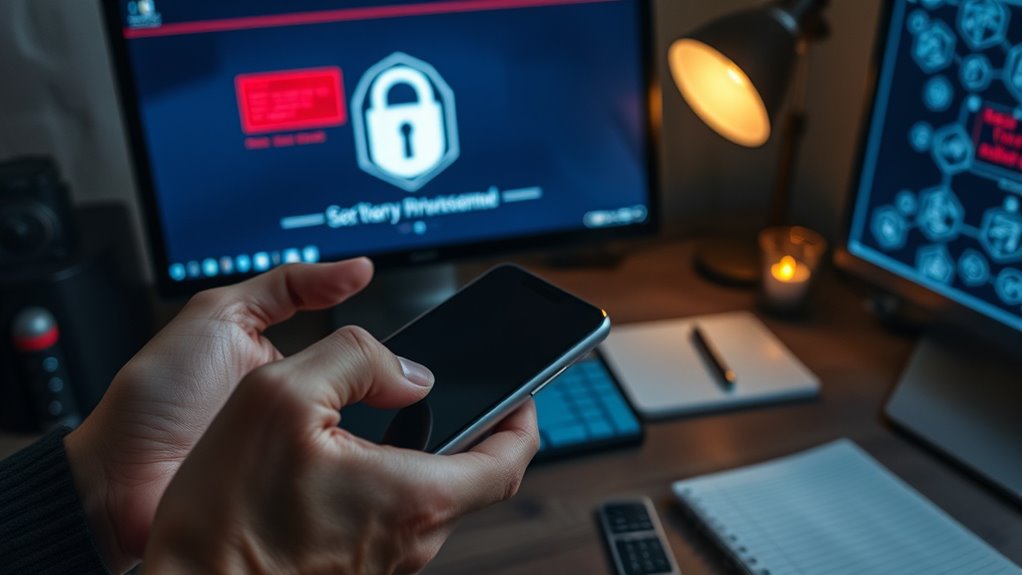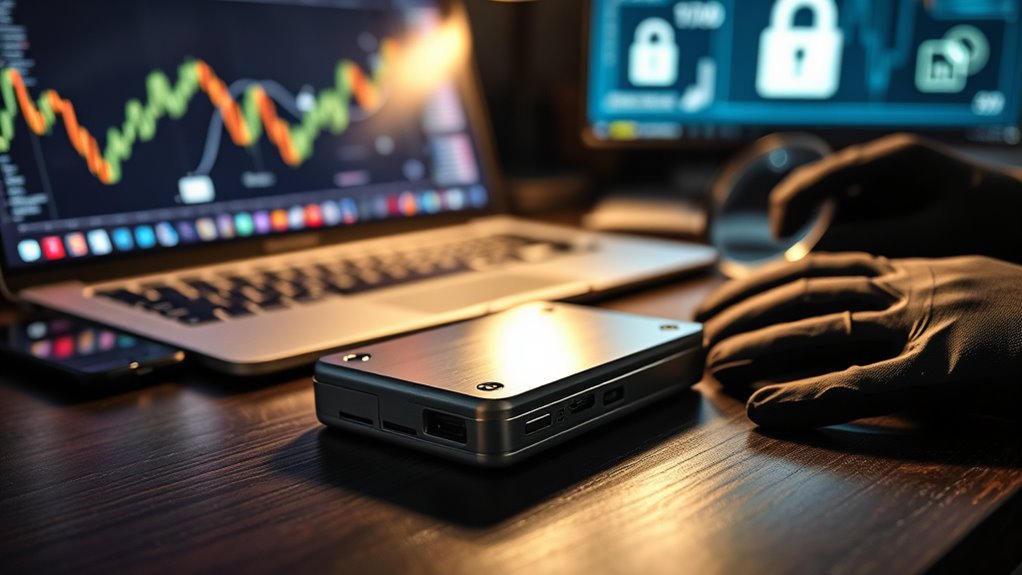To protect your crypto IRA from scams, stay alert to evolving tactics like deepfake impersonations and AI-driven schemes that target your trust. Use strong security measures such as two-factor authentication, cold storage wallets, and blockchain analytics to track suspicious activity. Regularly update your software and stay informed about new scams. By taking these steps, you reduce risks and strengthen your defenses—continuing to learn more can help you stay ahead of threats.
Key Takeaways
- Enable two-factor authentication and use strong, unique passwords to secure access to your crypto IRA accounts.
- Use hardware wallets and cold storage to protect assets from online hacking and phishing attacks.
- Regularly update software, security protocols, and stay informed about current scam techniques like deepfake impersonations.
- Verify the legitimacy of investment opportunities and be cautious of high-yield promises or suspicious project claims.
- Utilize blockchain analytics and KYC procedures to detect and prevent fraudulent transactions within your crypto IRA.

Are you aware of how rapidly crypto scams are evolving and the threats they pose? As the crypto landscape grows, scammers are getting more sophisticated, leveraging advanced technology to deceive unsuspecting investors. One of the main trends is AI-driven scams, where deepfake videos and audio impersonate trusted figures, making scams more convincing and harder to spot. These deepfakes can convincingly mimic CEOs, financial advisors, or celebrities, tricking you into sharing sensitive information or transferring funds. High-yield investment scams remain prevalent, enticing you with promises of quick, guaranteed profits. These schemes often involve fake projects or tokens, luring victims into “investing” large sums only to vanish with your money.
Pig butchering schemes have also become more refined. In these scams, fraudsters build genuine-seeming relationships with victims over time, gaining trust before executing fraudulent activities. They might pose as friends, romantic interests, or professional contacts to lure you into revealing private details or investing in bogus ventures. Deepfake authorization scams are another dangerous development. Criminals impersonate senior management within companies to divert funds or sensitive information, exploiting trust within corporate environments. Such scams are particularly damaging because they leverage the authority of high-ranking executives, making it easier to manipulate employees into complying with fraudulent requests. The use of AI-generated deepfakes to impersonate trusted figures has increased by over 300% in the past year, making these scams even more convincing.
Crypto crime statistics reveal the scale of the problem. In 2024, around $12 billion was lost to scams, with nearly $3.1 billion stolen in the first half of 2025 alone. Victims span all demographics, but seniors are especially vulnerable, often falling prey to phishing, fake ATM scams, or Ponzi schemes. Over 150,000 scam complaints were filed in the U.S. last year, highlighting the widespread concern. Hackers also stole $2.2 billion worth of cryptocurrency in 2024, emphasizing the importance of securing your assets. Stablecoins, due to their liquidity and widespread use, are now commonly used for laundering illicit funds, making security even more critical.
To protect yourself, adopt robust security measures. Blockchain analytics tools help track suspicious transactions, while stricter KYC regulations aim to prevent identity theft. Regularly updating your software and hardware reduces vulnerabilities, and enabling two-factor authentication adds an extra layer of security. Using cold storage offline wallets ensures your crypto remains safe from online hacks. Staying vigilant and educated about current scams can help you recognize warning signs before falling victim. Law enforcement agencies and regulatory bodies are working tirelessly to develop stricter rules and international cooperation to trace stolen funds. AI advancements are also improving scam detection, analyzing transaction patterns and identifying anomalies early. Implementing these defenses and staying informed can considerably reduce your risk, helping you safeguard your crypto IRA against the rapidly evolving threats in the digital currency space. [Understanding these threats and implementing proactive security measures is crucial for protecting your investments.
Frequently Asked Questions
How Can I Verify the Legitimacy of a Crypto IRA Provider?
To verify a crypto IRA provider’s legitimacy, start by checking their licensing and registration with relevant financial authorities. Look for transparent fee structures and clear contact information. Read reviews and testimonials from other investors, and research their track record in the industry. Make certain they use secure, reputable custodians and have robust security measures. Trust your instincts—if something feels off, consider exploring other providers to protect your investment.
What Are the Signs of a Potential Crypto Scam?
You should watch out for red flags like promises of guaranteed high returns with little risk, pressure to invest quickly, and unprofessional websites or communication. Be cautious if the provider avoids transparent fee disclosures or lacks proper licensing and regulation. If they push unsolicited offers or seem too good to be true, trust your instincts and do thorough research before investing. Always verify credentials and consult trusted financial advisors to avoid scams.
Are There Specific Regulations Protecting Crypto IRA Investors?
Yes, there are specific regulations protecting your crypto IRA investments. The IRS classifies cryptocurrencies as property, and custodians must follow strict rules to guarantee compliance. The SEC also oversees certain aspects of crypto transactions. You should choose a reputable custodian registered with the IRS and ensure they follow proper security procedures. Always verify that your provider adheres to regulations to help safeguard your investment from fraud and misuse.
How Often Should I Review My Crypto IRA Security Measures?
You should review your crypto IRA security measures at least quarterly. Regular checks help you spot vulnerabilities, update passwords, and guarantee your storage methods remain secure. If there’s a significant market change or news about potential threats, review your security immediately. Staying proactive keeps your investments safe from scams and hacking attempts. Make it a routine to stay one step ahead and protect your crypto assets effectively.
What Steps Should I Take if I Suspect a Scam?
Oh, the irony of catching a scammer—act fast! First, disconnect from any linked accounts and avoid sharing personal info. Then, report the scam to your platform and authorities. Change your passwords and enable two-factor authentication. Check your account activity for unauthorized transactions. Finally, stay alert and educate yourself on common scam tactics so you won’t fall for it again. Quick action keeps your crypto safe!
Conclusion
So, take charge of your crypto IRA like a savvy hero wielding a digital sword, not a clueless tourist handing over your keys to every scammer waving a fake ID. Remember, in this wild crypto jungle, a little skepticism goes a long way—think of it as your neon sign flashing “Trust nobody, verify everything.” Stay alert, stay secure, and don’t let scammers turn your crypto treasure into a digital pirate’s plunder.









